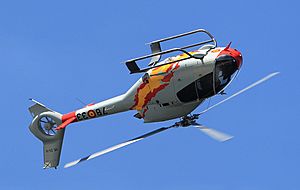Aerobatics facts for kids

Aerobatics is a type of flying where pilots do amazing tricks with their aircraft. These tricks are not used in normal passenger flights. The word "aerobatics" comes from "aeroplane" and "acrobatics."
Pilots perform aerobatics in aeroplanes and gliders. They do it for training, fun, shows, and sports. Some helicopters, like the MBB Bo 105, can also do a few aerobatic moves. The Westland Lynx helicopter can even do loops and rolls!
Most aerobatic moves involve spinning the aircraft around its long body or tilting it up and down. Other moves, like a spin, make the aircraft turn sideways. Pilots often combine these moves to create a full show or competition routine. Aerobatic flying needs many special skills. It also puts more stress on the aircraft than regular flying. In some countries, pilots must wear a parachute when doing aerobatics.
Aerobatic training helps pilots learn how to recover from unusual flight situations. Because of this, it is part of many flight safety programs. Many pilots fly aerobatics for fun. Others choose to compete in aerobatic competitions, which is a judged sport.
Contents
What is Aerobatics?
In the early days of flying, some pilots used their aircraft to entertain people. They were like a "flying circus." They flew cool moves to impress onlookers. Later, pilots found that some of these moves helped them in air combat. This was useful during dogfights between fighter planes.
Aerobatic aircraft come in two main types. There are specialist aerobatic planes and aerobatic-capable planes. Specialist designs, like the Pitts Special or the Extra 300, are built for top performance. They are amazing at tricks. But they are not as good for long trips or easy landings.
Aerobatic capable aircraft, like the Cessna 152 Aerobat, can do both. They can carry passengers and luggage. They can also perform basic aerobatic moves.
Team Flying and Jets
Flight formation aerobatics are done by teams of aircraft. These teams can have up to sixteen planes. Most teams fly with four to ten aircraft. Some teams are funded by their country's armed forces. Others get money from companies. They often use colored smoke to show the patterns they fly. This smoke can also show the colors of a national flag.
Jet-powered aircraft do aerobatics differently. They cannot use the same spinning forces as propeller planes. Jets also fly much faster. This makes their moves bigger and means the pilot feels strong G-forces for longer. Jet aerobatic teams often fly in formations. This limits the types of moves they can do safely.
Aerobatics done close to the ground for an audience is called "stunt flying." To make the show better, pilots sometimes make smoke. The smoke helps people see the path the aircraft takes. This smoke is not from burning fuel. It comes from special oil that turns into a fine mist. The oil is either sprayed into the hot engine exhaust or a special device. The first military team to use smoke was the "The Black Cats" in 1957.
Training and Safety
Military fighter pilots learn aerobatics to improve their flying skills. They also learn it for combat tactics. Many aerobatic moves, like the Immelmann turn, were first used in wars.
Aerobatics and formation flying are not just for planes. The British Army, Royal Navy, Spanish Air Force, and Indian Air Force all have helicopter display teams.
All aerobatic moves need lots of training and practice. This helps pilots avoid accidents. Accidents are very rare in aerobatic competitions. Most accidents happen during formation flying or stunt flying at low levels. These often occur at airshows or air racing events. Low-level aerobatics are very challenging. Airshow pilots must prove their skills before they can fly their shows closer to the ground.
In the EU, you need special training and a rating to fly aerobatics. In Canada, no special license is needed to do aerobatics. But to carry passengers during aerobatics, a pilot needs special training. This includes at least 10 hours of aerobatic flight lessons. Or they need 20 hours of total aerobatic experience.
Competitions
Aerobatic flying competitions happen all over the world. They are a bit like the Olympic games for flying. The FAI Aerobatics Commission (CIVA) sets the rules for these events.
Competitions start at a beginner level. Then they get harder through Sportsman, Intermediate, and Advanced levels. "Unlimited" is the top competition level. Experienced aerobatic pilots can feel forces of about plus or minus 5 Gs for short times. Unlimited pilots do more extreme moves. They can experience even higher G levels, sometimes up to +8 or -6 Gs.
Positive Gs push you down into your seat. Negative Gs lift you up. Pilots can handle more positive Gs than negative Gs. This is because they can control blood flow better with positive Gs. But generally, feeling +9 Gs for more than a few seconds can make a pilot lose consciousness. This is called GLOC.
Where to See Aerobatics
You are most likely to see aerobatics at public airshows. This is where pilots perform stunt flying. Aerobatic competitions usually do not attract huge crowds. This is because the moves are flown at safe, higher altitudes to avoid accidents.
See also
- List of air display teams
- List of aerobatic aircraft
- Aero GP
- Aerobatic maneuver
- Aerobatic pilots
- Aerobatics (radio-controlled aircraft)
- Air racing
- Aresti Catalog
- Competition aerobatics
- Flight dynamics
- Flypast
- HASELL




